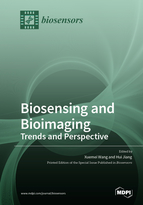Biosensing and Bioimaging: Trends and Perspective
A special issue of Biosensors (ISSN 2079-6374). This special issue belongs to the section "Biosensors and Healthcare".
Deadline for manuscript submissions: closed (20 November 2021) | Viewed by 18430
Special Issue Editors
Interests: cancer diagnostic technique; disease diagnostic biosensor; in vivo fluorescence/nuclear magnetic imaging; cancer multifunctional therapy
Special Issues, Collections and Topics in MDPI journals
Special Issue Information
Dear colleague,
Bioimaging and biosensing are active areas that are continuing to attract attention in various fields in the understanding of some important disease mechanisms and relevant biological processes, especially in precise theranostics and effective treatment of cancers and other diseases. The development of novel bio-responsive material-based biosensors and intelligent supramolecules / and nanoscale probes have facilitated the target bioimaging and smart nano-medicine. Substantial interest has been focused on research to develop fluorescence and non-fluorescence smart nanomaterials, including the design and fabrication of multimodal contrast agents with fluorescent, magnetic, or high X-ray attenuation property, surface-enhanced Raman scattering probes, and plasmonic nanoprobes, among others, for high-resolution imaging and sensing.
This collection of reviews and research articles in this Special Issue of Biosensors on the topic of "Biosensing and Bioimaging" will highlight developments in intelligent supramolecules and smart nanostructural probes for bioimaging and biosensing applications. The topics include fluorescent nanorobot-based bioimaging, electrochemical biosensors, plasmonic/SERS nanoprobes, multimodal bioimaging, and so on.
Prof. Dr. Xuemei Wang
Dr. Hui Jiang
Guest Editors
Manuscript Submission Information
Manuscripts should be submitted online at www.mdpi.com by registering and logging in to this website. Once you are registered, click here to go to the submission form. Manuscripts can be submitted until the deadline. All submissions that pass pre-check are peer-reviewed. Accepted papers will be published continuously in the journal (as soon as accepted) and will be listed together on the special issue website. Research articles, review articles as well as short communications are invited. For planned papers, a title and short abstract (about 100 words) can be sent to the Editorial Office for announcement on this website.
Submitted manuscripts should not have been published previously, nor be under consideration for publication elsewhere (except conference proceedings papers). All manuscripts are thoroughly refereed through a single-blind peer-review process. A guide for authors and other relevant information for submission of manuscripts is available on the Instructions for Authors page. Biosensors is an international peer-reviewed open access monthly journal published by MDPI.
Please visit the Instructions for Authors page before submitting a manuscript. The Article Processing Charge (APC) for publication in this open access journal is 2700 CHF (Swiss Francs). Submitted papers should be well formatted and use good English. Authors may use MDPI's English editing service prior to publication or during author revisions.








